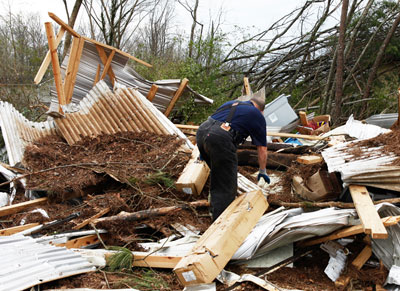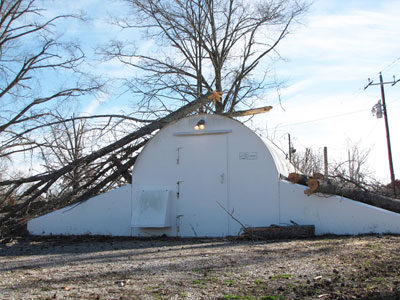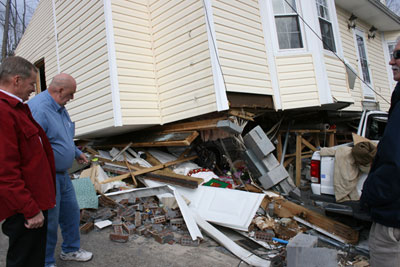
As some Alabama jurisdictions continue to recover following a rare January 23 outbreak of 11 tornadoes that claimed two lives and caused an estimated $30 million in damages—less than a year after the April 27, 2011, Super Outbreak of tornadoes that caused 248 deaths and an estimated $3 billion in damages—state officials are eyeing ways to plan, organize and build better and stronger for future disasters.
In the aftermath of the April 27, 2011, Super Outbreak of tornadoes, Governor Robert Bentley appointed 19 community and corporate leaders to serve on the Tornado Recovery Action Council (TRAC) of Alabama to document what happened on the historic day, to determine what went right and what could have been done better, and to propose solutions to build a safer state.
 |
|
An EF-3 tornado survivor in Center Point, Alabama, sorts through debris to find any salvageable belongings. (Photo by David Fine/FEMA) |
"The Code Council applauds the efforts of the Tornado Recovery Action Council and extends its assistance to state officials as they implement measures to build a safer Alabama," said ICC Chief Operating Officer Dominic Sims. "Applying lessons learned is a fundamental step in the mitigation process, as the science of building safety continues to evolve to protect citizens and their property from future disasters."
In 2010, the Alabama Energy and Residential Code Board began the process to adopt the 2009 versions of the International Building, Fire, Fuel Gas, Mechanical, Plumbing and Residential Codes, as well as ICC 500: Standard for the Design and Construction of Storm Shelters. Currently, the Board has no inspection or enforcement authority, and according to TRAC some 60 of Alabama's 67 counties and 90 percent of its municipalities do not enforce codes and are exempt until they adopt them.
Unified code adoption and enforcement is critical to the state's long-term success in disaster mitigation, said Lannie Smith, Chief Building Official for Orange Beach, Alabama, an ICC Governmental Member that was not affected by the April 2011 or January tornadoes but is no stranger to severe weather events, including Hurricane Ivan in 2004 which caused an estimated $2 billion in damages. "A code here and a code there is absolutely the wrong way to do it," Smith said.
State Insurance Commissioner Jim Ridling agrees, saying the challenges of adopting and enforcing statewide codes in rural areas will be worth the effort. "They would be very difficult to enforce out in some rural counties, and having the right kind of inspection process (also would be difficult)," he said. "But obviously that makes sense to have one statewide."
 |
|
An estimated 150 residents took refuge in a community storm shelter in Maplesville, Alabama, as a tornado struck western Chilton County on January 23. (Photo by David Fine/FEMA) |
Three TRAC recommendations include increasing the number of storm shelters available to the public, and publicizing their locations so people know where to go when severe weather approaches; offering incentives to add safe rooms to new construction as well as existing homes and businesses; and working with industry representatives to require that community storm shelters be included at any new apartment complexes and mobile home communities built in tornado-prone regions, and offer incentives for adding them to existing facilities.
The TRAC report states: "Within six months of the April 27 tornadoes, approximately 383 applications for matching grants to build community storm shelters had been submitted to the Alabama Emergency Management Agency (AEMA). That's a good start." As of February 1, the Federal Emergency Management Agency had approved grants for 1,159 storm shelters at private homes, according to the AEMA.
More than 700 homes and businesses were damaged or destroyed during separate EF-3 tornadoes that touched down in Jefferson County, Alabama, in the early morning hours of January 23. Two of the hardest hit areas were the cities of Clay and Center Point, both ICC Governmental Members. More than 200 houses in at leave five subdivisions in Clay were either destroyed by one of the tornadoes or had damage to at least 50 percent of the structure.
A weary Clay Building Inspector and Public Works Director Lynn Burch reported after the storm that progress was being made as city personnel worked with FEMA inspection teams to perform damage assessments. "I'm tired, I'm numb, but it's going to get better," he said. In the aftermath of the storm, the city has used its website and Facebook page to communicate key messages to residents and volunteers, including the process for contractors to obtain business licenses before rebuilding projects begin. Persons who have obtained business licenses can be identified by having neon-colored cards in their vehicles.
 |
|
Stan Leo (center), Gary Nichols of ICC-ES (left) and John Battles of the Code Council examine how Leo's home shifted 20 feet off its foundation during an EF-3 tornado in Jefferson County, Alabama. (Photo by Trey Hughes/ICC) |
Stan Leo said he was extremely diligent while their home was built in 1986 by insisting on the use of tongue and groove roof decking that was fastened by screws and installing 2x6 studs in exterior walls. "The only thing I didn't do was pour the foundation blocks with concrete and use reinforced bar," he said. "That was my mistake. But I made sure everything else was done right. I brought my level and square with me every afternoon. I made sure every nail was hand-driven. The contractor hated to see me coming."